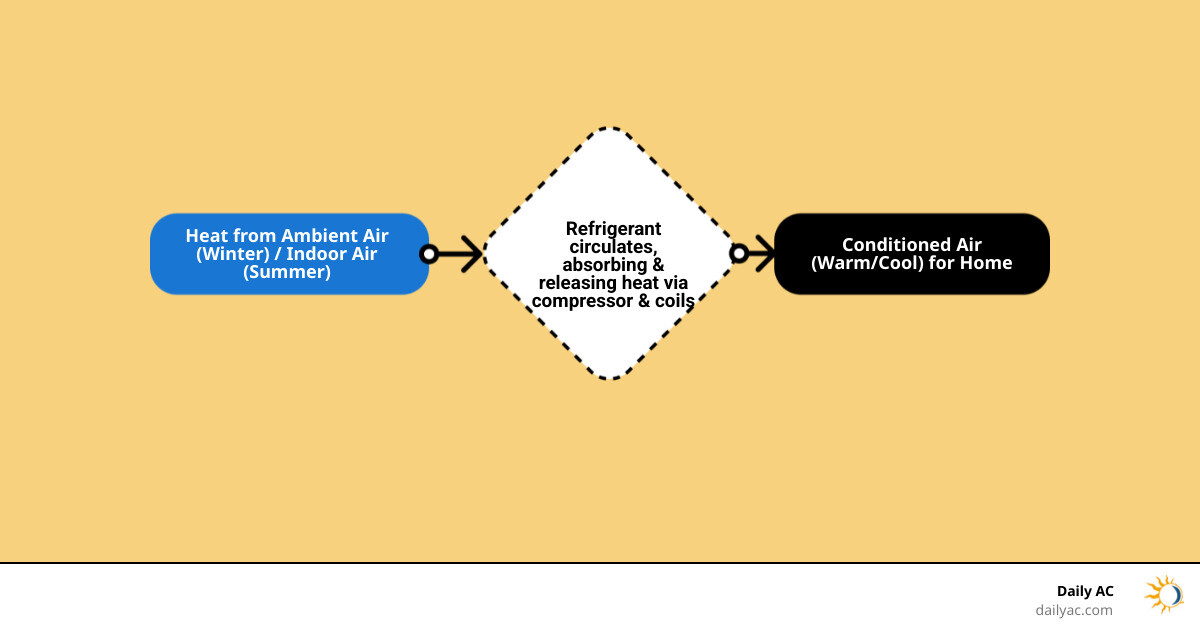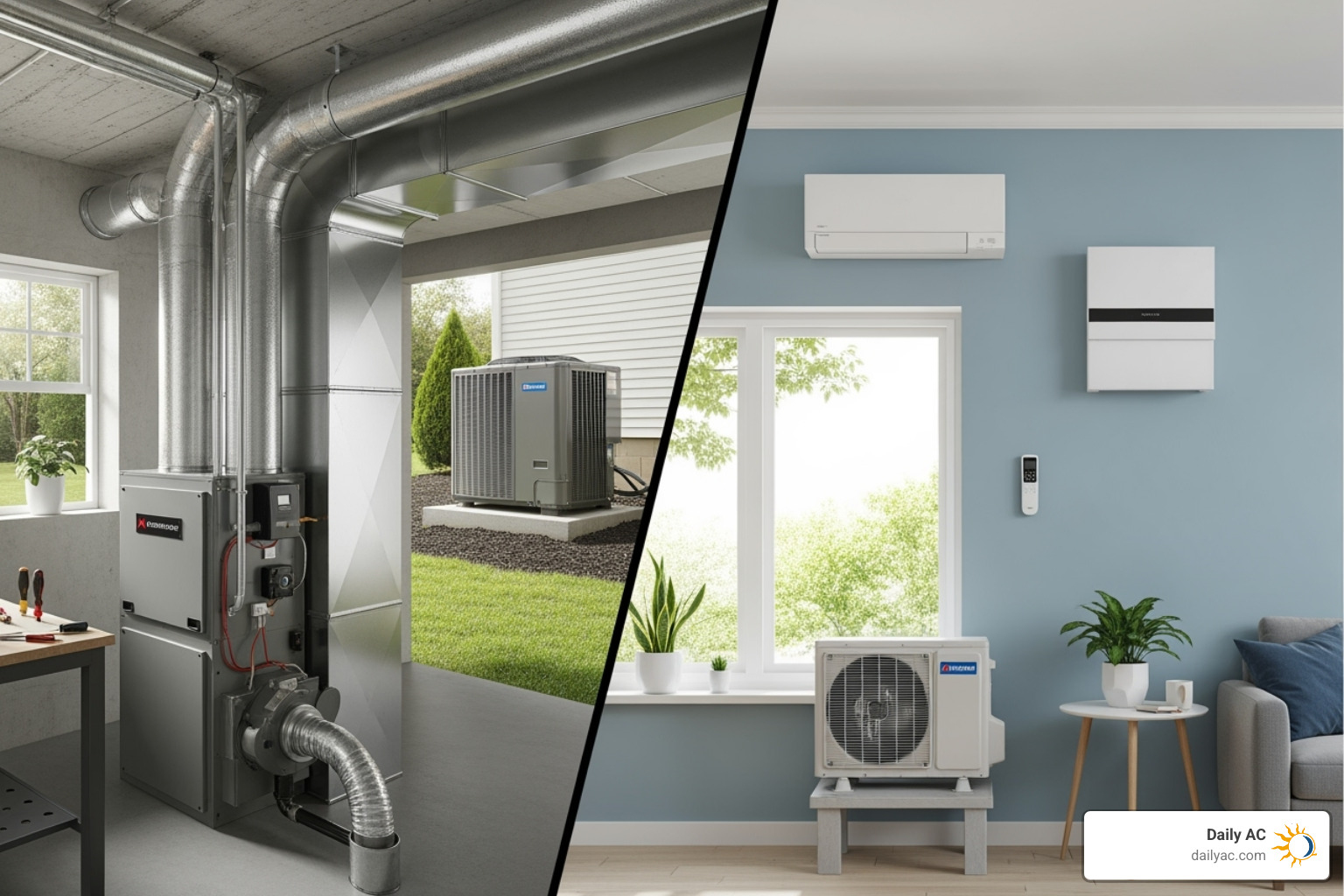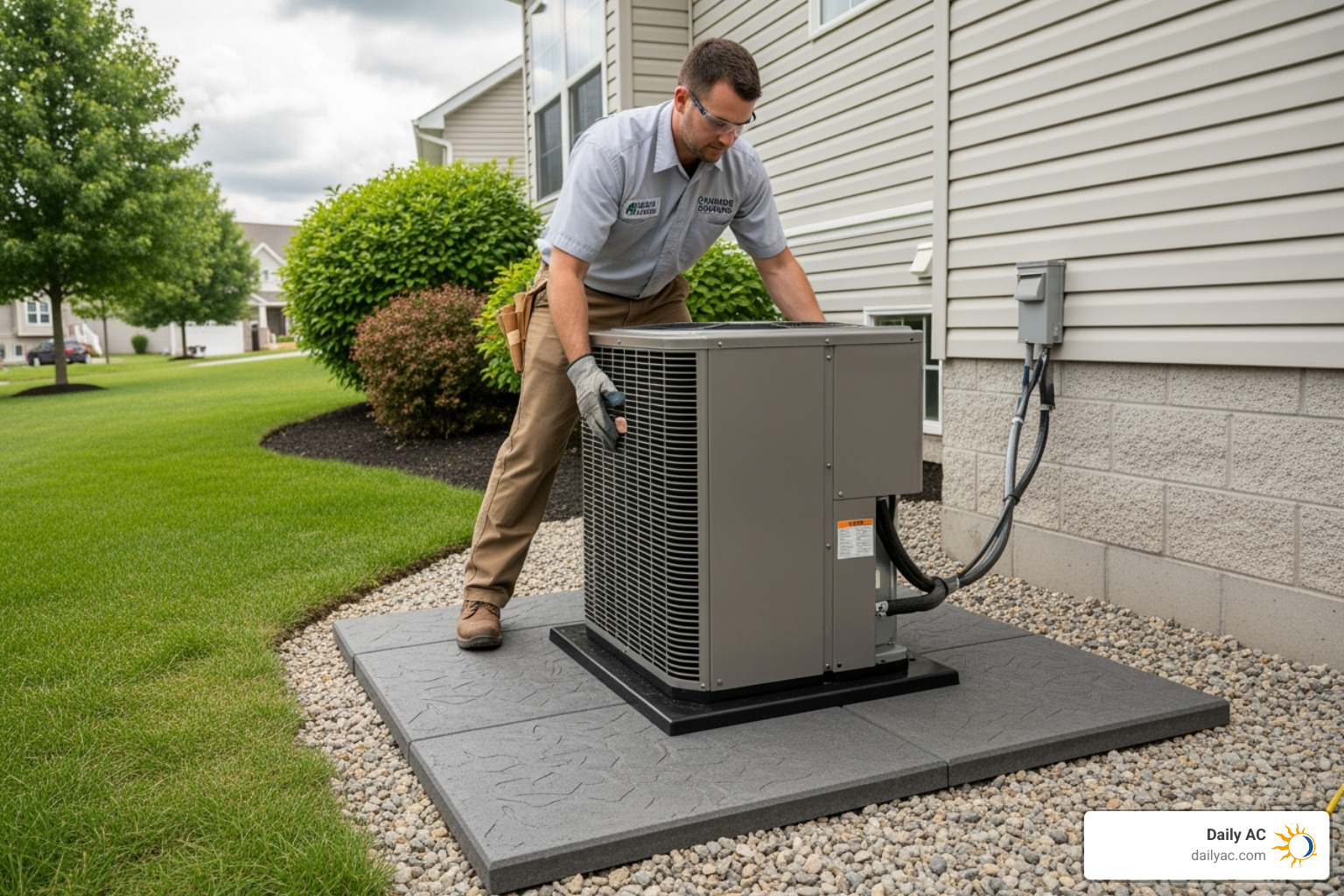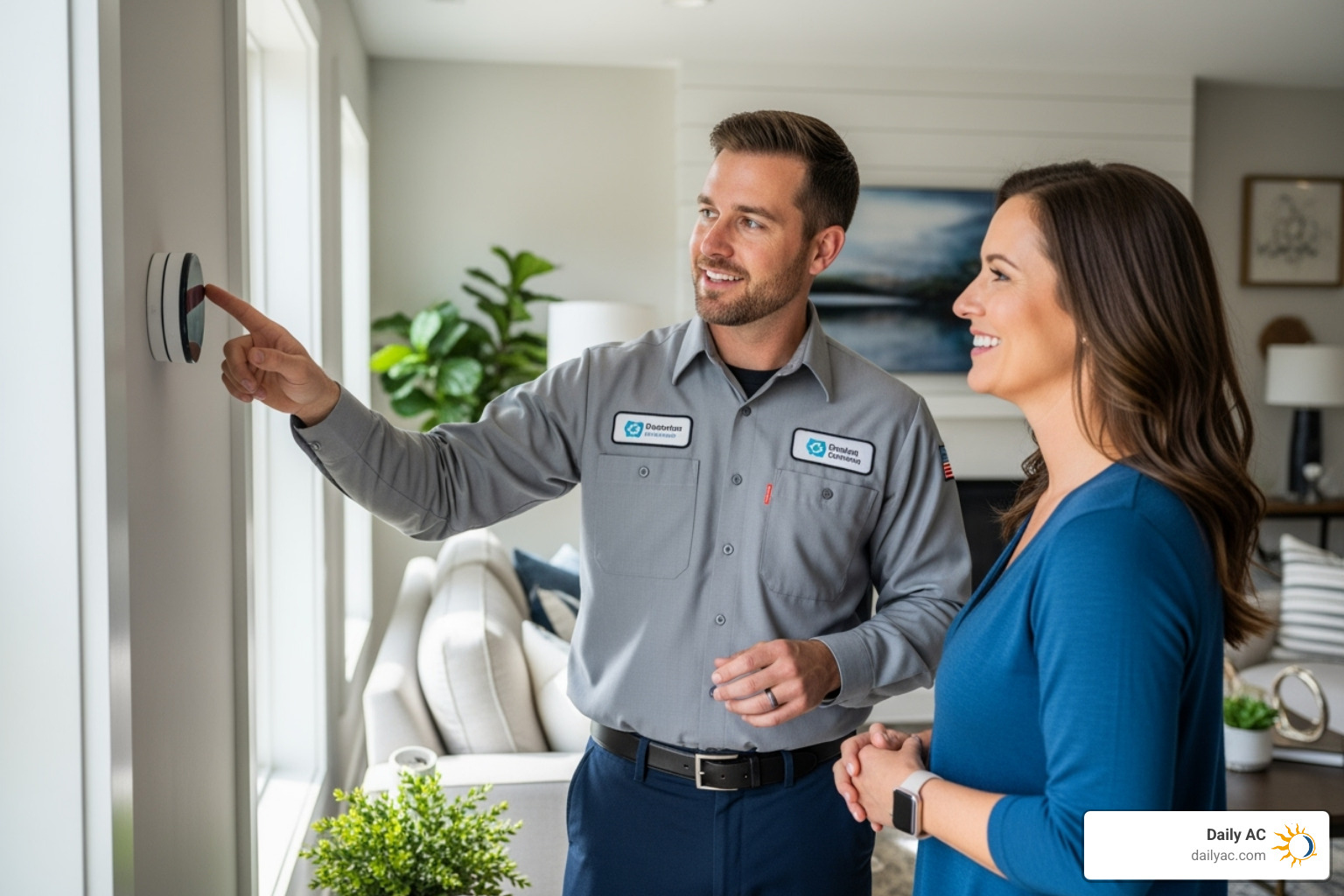Why Installing a Heat Pump System Transforms Your Home’s Energy Efficiency
When you install heat pump system technology in your home, you’re making a smart investment that can reduce your electricity use for heating by up to 75% compared to electric resistance heating. These innovative systems work differently than traditional HVAC equipment – instead of creating heat or cold air, they transfer existing heat from one place to another.
Key benefits of heat pump installation:
- Year-round comfort – One system provides both heating and cooling
- Energy savings – Up to 75% reduction in heating electricity costs
- Better air quality – Superior dehumidification compared to standard AC
- Environmental impact – Significantly lower carbon footprint
- Advanced efficiency – Modern units achieve exceptional SEER and HSPF ratings
Heat pumps function like a refrigerator in reverse. During summer, they extract heat from inside your home and move it outdoors for cooling. In winter, they pull heat from outdoor air (even when it’s cold) and transfer it inside for heating. This heat transfer process makes them far more efficient than systems that generate heat through combustion or electric resistance.
High-efficiency heat pumps also dehumidify better than standard central air conditioners, creating more comfortable indoor conditions while using less energy. Today’s advanced models include features like variable-speed compressors and ENERGY STAR certifications that maximize both comfort and savings.
The installation process requires professional expertise to ensure proper sizing, safe refrigerant handling, and optimal performance. Most installations take about 4-8 hours and follow strict safety protocols to protect your home and family.
Basic install heat pump system glossary:
Before the Installation: Planning for Maximum Efficiency
The secret to a successful install heat pump system project isn’t the fancy equipment – it’s what happens before we even unpack the first box. Think of it like baking a perfect cake. You wouldn’t just throw ingredients together and hope for the best, right? Your home needs the same careful preparation.
Your home assessment is where we become detectives. We’re looking at your home’s unique personality – its insulation levels, those sneaky air leaks that let your money escape, and how well your existing ductwork can handle its new job. Older homes especially need some TLC before we install heat pump system components. Poor insulation is like wearing a winter coat with holes in it – your heat pump will work overtime trying to keep up.
The condition of your existing ductwork tells us a lot about how effectively your new system will distribute comfort throughout your home. Sometimes we find that a few ductwork improvements can dramatically boost your system’s performance. Our guide on What is Needed to Install Central Heating? walks you through exactly what we look for during this crucial phase.
Here’s where many contractors take shortcuts, but we never do: proper system sizing. Forget the old “bigger is better” mentality or guessing based on square footage alone. We use something called a Manual J Load Calculation – it’s like a comprehensive physical exam for your home.
This detailed assessment considers everything from your insulation thickness and window types to ceiling heights and even how many people live in your home. We look at your foundation type, the direction your house faces, and dozens of other factors that affect how much heating and cooling you actually need.
Why does this matter so much? Because 90% of HVAC systems are installed incorrectly, often due to improper sizing. An oversized system will short-cycle (turn on and off constantly like a nervous driver), while an undersized system will run continuously, struggling to keep up. Both scenarios waste energy and leave you uncomfortable.
When we install heat pump system equipment that’s perfectly matched to your home’s needs, magic happens. Your system runs efficiently, maintains consistent temperatures, and saves you money every month. For more insights into choosing the right system, check out A Guide to Heat Pump Selection.
Choosing Your Heat Pump Type
Now comes the fun part – picking your perfect match from the heat pump family. Each type has its own personality and ideal living situation.
Air-source heat pumps are the popular kids on the block, and for good reason. They transfer heat between your home and outdoor air with remarkable efficiency. Modern versions have gotten incredibly smart about working in cold weather – they can pull heat from air even when it’s freezing outside. It’s like having a friend who’s reliable in any weather.
Ground-source or geothermal heat pumps are the overachievers of the group. They tap into the earth’s stable underground temperatures through buried piping systems. While the initial installation is more complex, these systems use up to 61% less energy than standard models. Their underground loops can last over 50 years, making them incredibly durable investments.
Ductless mini-split systems are perfect problem-solvers for homes without existing ductwork. They consist of an outdoor unit connected to strategically placed indoor units, giving you precise zone control. Want the bedroom cooler but the living room warmer? No problem.
Dual-fuel or hybrid systems are the smart compromisers. They combine a heat pump’s efficiency with a gas furnace’s reliability. The heat pump handles mild weather beautifully, then the furnace steps in when temperatures drop significantly. It’s like having two specialists working together.
Modern heat pumps also come with impressive advanced features. Variable-speed compressors are game-changers – they adjust their output precisely to match your home’s needs instead of just cycling on and off. This means quieter operation, more consistent temperatures, and serious energy savings.
For a comprehensive look at all your options, explore Choosing the Best Heat Pump.
| Feature | Air-Source Heat Pump | Ground-Source Heat Pump (Geothermal) |
|---|---|---|
| Installation Complexity | Moderate (requires outdoor unit, refrigerant lines, electrical) | High (requires extensive excavation for ground loops, complex piping) |
| Efficiency | High (up to 75% electricity reduction for heating) | Very High (61% less energy than standard models) |
| Ideal Use Cases | Most homes, varied climates, cost-effective upfront | New construction, large properties, desire for ultimate efficiency, long-term savings |
| Outdoor Footprint | Visible outdoor unit | Minimal to no visible outdoor components (ground loops buried) |
| Longevity | Typically 10-15 years | Indoor components 24 years, ground loops 50+ years |
Understanding Efficiency and Certifications
Let’s decode those alphabet soup ratings you’ll see on heat pump labels. SEER (Seasonal Energy Efficiency Ratio) measures cooling efficiency, while HSPF (Heating Seasonal Performance Factor) measures heating efficiency. Higher numbers mean better efficiency and lower operating costs – it’s that simple.
The EPA’s ENERGY STAR certifications act like a quality seal of approval. When you see an ENERGY STAR® certified heat pump, you know it meets strict efficiency guidelines that translate to real savings on your utility bills and a smaller carbon footprint.
If you live where winter really means business, look for the ENERGY STAR Cold Climate label. These specially designed systems perform efficiently even when temperatures drop to 5°F – perfect for those unexpectedly cold Florida mornings (yes, they do happen!).
At Daily AC, we’re committed to bringing you the most efficient solutions available. Our detailed guide on Revolutionizing Home Comfort: The Remarkable Efficiency of Modern Heat Pumps shows just how far this technology has advanced.
The Professional Process to Install a Heat Pump System
Getting excited about your new heat pump is natural, but the actual install heat pump system process is where the magic happens – and where expertise matters most. This isn’t a weekend DIY project. The complexity of modern heat pump installation requires specialized knowledge, professional-grade tools, and years of experience to get right.
Here’s something that might surprise you: a staggering 90% of all HVAC systems are installed incorrectly. That’s not just disappointing – it’s expensive. Poor installation leads to higher energy bills, frequent breakdowns, and equipment that gives up years before it should. Even worse, improper installation can create safety hazards that put your family and property at risk.
Our certified technicians take a completely different approach. We follow strict safety protocols and meet all regulatory requirements from start to finish. One critical area is refrigerant handling – these substances require special EPA certification to manage safely and legally. According to the EPA standards, venting refrigerants into the atmosphere is prohibited, so we use specialized recovery equipment to capture and properly dispose of old refrigerant.
We also handle all the paperwork you probably don’t want to deal with. Local permits, building code compliance, and inspection scheduling – we’ve got it covered. This ensures your installation meets every requirement and protects your investment.
Preparation and Old System Removal
Before any new equipment arrives, we transform your home into a proper work site. Our team carefully clears work areas around both indoor and outdoor locations, then protects your floors and furniture with coverings. Nobody wants HVAC dust on their favorite couch.
Safety comes first, so we always start by disconnecting power to your existing system at the main electrical panel. No shortcuts, no exceptions.
If you’re replacing an older system, the next step involves some serious environmental responsibility. That old refrigerant can’t just disappear into thin air – literally. Our technicians connect recovery machines to safely capture every bit of refrigerant from your old system. This protects the environment and keeps us compliant with federal regulations.
Once the refrigerant is safely contained, we methodically disconnect and remove the old outdoor unit. Inside your home, we carefully extract the old evaporator coil from your air handler or furnace. Every component gets disposed of properly because that’s just how we roll.
How to properly install a heat pump system
Now comes the exciting part – bringing your new system to life. Each step requires precision because even small mistakes can cause big problems down the road.
Placing the outdoor unit is more involved than you might think. These units can weigh up to 300 pounds, so they need a rock-solid foundation. We install a level composite pad that can handle the weight and weather for years to come. Proper placement also means ensuring at least two feet of clearance on all sides. Your heat pump needs room to breathe – literally. Without adequate airflow, efficiency drops and problems multiply.
Installing the indoor unit varies depending on your home’s setup. Whether we’re installing a complete air handler or mounting an evaporator coil on your existing furnace, everything must connect seamlessly to your ductwork system. Proper alignment and secure mounting ensure efficient air distribution throughout your home.
Connecting refrigerant lines is where our expertise really shows. These copper lines carry the refrigerant that makes heat transfer possible. We use a specialized welding technique called brazing to create connections that are absolutely leak-proof. Even tiny leaks can slash your system’s efficiency and lead to expensive repairs later.
Electrical wiring requires both skill and certification. Your heat pump needs dedicated electrical connections for both indoor and outdoor units. Our qualified electricians handle all high-voltage and low-voltage wiring, connecting everything safely to your electrical panel. If needed, we’ll also install a new service disconnect box near your outdoor unit.
Connecting the thermostat completes the installation puzzle. Think of your thermostat as mission control for your comfort system. We connect and program it to communicate perfectly with your heat pump, setting up heating mode, cooling mode, and any auxiliary heat functions. Everything gets tested to ensure smooth operation.
This comprehensive approach to install heat pump system technology means every detail gets handled with care and precision. From foundation to final connection, we’re setting your system up for years of reliable, efficient performance. For more detailed information about our residential installation process, check out Residential Heat Pump Installation.
After Installation: Commissioning and Long-Term Care
The moment our team finishes connecting all the components, your new heat pump is ready for its first test run. But we don’t just flip the switch and call it a day – there’s still important work ahead to ensure everything operates perfectly.
A typical install heat pump system project takes anywhere from four to eight hours, depending on your home’s specific setup and whether we need to modify any existing ductwork. Homes without existing ducts or those requiring electrical upgrades might take a bit longer, but we’ll keep you informed every step of the way.
Now comes one of the most critical phases: commissioning your new system. Think of this as your heat pump’s final exam – we’re making sure it passes with flying colors before we hand over the keys to your comfort.
Our technicians start with system startup, carefully powering up your new heat pump and watching how it responds during its first operation. Next, we check the refrigerant charge with precision instruments. This isn’t just a quick glance – refrigerant levels must be exactly right, as even small variations can slash your efficiency and shorten your system’s life.
The testing phase is where we really put your heat pump through its paces. We thoroughly test heating mode, cooling mode, and the defrost cycle that keeps your system running smoothly in winter. For heat pumps, this commissioning process typically takes 45 minutes to two hours – longer than a standard AC unit because we’re testing more functions. We check airflow rates, measure temperature differences between supply and return air, and verify that all components work together like a well-orchestrated team.
The final walkthrough is honestly our favorite part of the entire process. This is when we get to show you all the amazing features of your new system and watch your excitement as you realize how much more comfortable your home will be. We’ll explain how to use your thermostat effectively, point out the different settings for optimal efficiency, and answer every question you have. We want you walking away feeling completely confident about operating your new heat pump.
Ongoing Maintenance for Peak Performance
Your heat pump is now installed and running beautifully, but like any sophisticated piece of equipment, it needs some TLC to keep performing at its best. The good news? Most of this maintenance is pretty straightforward.
Changing air filters regularly is probably the most important thing you can do for your system. We recommend swapping them out every one to three months, though homes with pets or family members with allergies might need more frequent changes. Clean filters mean better airflow, cleaner indoor air, and a system that doesn’t have to work as hard.
Keeping your outdoor unit clear is another simple but crucial task. Take a walk around your outdoor unit every few weeks and clear away any leaves, dirt, grass clippings, or snow that might be blocking the airflow. Your heat pump needs to breathe freely to work efficiently, and even small obstructions can impact its performance.
Scheduling annual professional tune-ups is where we come back into the picture. Even with your diligent care, having our technicians inspect and service your system at least twice a year helps catch small issues before they become big headaches. We’ll check refrigerant levels, clean coils, test all components, and make sure everything is running smoothly. Plus, most manufacturers require regular professional maintenance to keep your warranty valid.
If you ever notice unusual noises – buzzing, rattling, or sounds that just don’t seem right – don’t hesitate to give us a call. Sometimes a simple adjustment can prevent a much larger problem down the road. Our guide on Why is My Heat Pump Buzzing? can help you identify common sounds and when to reach out for help.
Following these maintenance practices isn’t just about keeping your warranty intact – it’s about ensuring your heat pump delivers the comfort and energy savings you invested in for many years to come. With proper care, your system will reward you with reliable performance and lower energy bills season after season.
Frequently Asked Questions about Heat Pump Installation
We love talking with homeowners about heat pumps, and over the years, we’ve noticed the same thoughtful questions come up again and again. Let’s explore the most common ones we hear.
How does installation differ for a home without existing ductwork?
If your home doesn’t have ductwork, don’t worry – you’re not out of luck! Ductless mini-split systems are actually a fantastic solution that’s becoming increasingly popular for exactly this situation.
Unlike traditional central systems that need extensive ductwork throughout your home, mini-splits work completely differently. They consist of an outdoor unit connected to one or more indoor units (we call these “heads”) through a small conduit that only requires a three-inch hole through your wall. These sleek indoor heads can be mounted on walls, ceilings, or floors, giving you incredible flexibility in placement.
What makes mini-splits especially appealing is their zone control capability. Each indoor head operates independently, so you can heat or cool only the rooms you’re actually using. This means you’re not wasting energy conditioning empty spaces – a smart approach that many homeowners love.
The installation process is much less invasive than installing new ductwork throughout your home. We can typically complete a mini-split installation without the major renovation work that central ducted systems would require. Whether you’re dealing with an older home that never had central air or you’re adding climate control to a new addition, mini-splits offer an neat solution. You can learn more about our comprehensive approach to these systems on our Central HVAC Services Davie FL page.
What are the main advantages of a heat pump over a traditional AC and furnace?
This is one of our favorite questions because heat pumps offer so many compelling advantages over traditional separate heating and cooling systems.
The most obvious benefit is having one system that handles both heating and cooling. Instead of maintaining and servicing both an air conditioner and a furnace, you have a single, integrated system. This simplifies everything from maintenance schedules to warranty coverage.
But the real game-changer is energy efficiency. Heat pumps don’t create heat – they move it around, which is far more efficient than generating heat through combustion or electric resistance. When you install heat pump system technology, you can see up to 75% reduction in heating electricity use compared to traditional electric heating methods. Overall, many homeowners experience up to 50% reduction in their total energy consumption.
Heat pumps also excel at dehumidification, which is particularly valuable here in South Florida. They remove moisture from your indoor air more effectively than standard air conditioners, creating a more comfortable environment and helping prevent issues like mold growth.
From an environmental perspective, heat pumps offer a significantly lower carbon footprint. Their exceptional efficiency means less energy consumption, and they can reduce your home’s reliance on fossil fuels for heating. It’s a win-win for both your utility bills and the environment.
How long does a new heat pump last?
With proper installation and regular care, your heat pump investment will serve you well for many years. Most air-source heat pumps typically last 10-15 years, though with excellent maintenance and professional tune-ups, we’ve seen many systems perform reliably for over 20 years.
Geothermal systems offer even greater longevity. The indoor components can last up to 24 years, while the buried ground loops often continue functioning for 50 years or more. It’s quite remarkable when you think about it.
The key factors that determine your system’s lifespan are the quality of the initial installation and your commitment to regular maintenance. This is why we emphasize the importance of professional installation – those statistics about 90% of HVAC systems being installed incorrectly aren’t just numbers; they represent real impacts on system longevity and performance.
Annual professional tune-ups make a tremendous difference in extending your system’s life. During these visits, we can catch small issues before they become major problems, ensure refrigerant levels are correct, clean coils, and verify all components are working efficiently.
If you’re wondering whether your current system might be approaching the end of its useful life, our article on Whether to Repair or Replace Your Heat Pump System can help guide your decision-making process.
Your Partner for a Flawless Heat Pump Installation
When you decide to install heat pump system technology in your home, you’re making one of the smartest investments possible for your family’s comfort and your wallet. The benefits speak for themselves: year-round heating and cooling from a single efficient system, energy savings that can cut your heating electricity use by up to 75%, improved comfort with better dehumidification, and the peace of mind that comes from environmental responsibility.
But here’s the thing – all these amazing benefits only happen when your system is installed correctly. Statistic we mentioned earlier? A staggering 90% of HVAC systems are installed incorrectly. That’s why trusting a qualified professional isn’t just recommended – it’s essential for getting the performance and savings you’re investing in.
At Daily AC, we’ve built our reputation on something simple but powerful: doing everything right the first time. While other companies focus on volume and rushing through installations, we focus on you – our customer relationship and the quality that ensures your system works flawlessly for decades to come. Our capable, friendly team takes the time to properly assess your home, size your system using Manual J calculations, and carefully handle every aspect of the installation process.
We understand that inviting technicians into your home is a big decision. That’s why we’re committed not just to technical excellence, but to treating your home with respect and keeping you informed throughout the entire process. From that initial assessment through the final walkthrough where we show you how to get the most from your new system, we’re with you every step of the way.
The Daily AC commitment means you can trust that your refrigerant lines are properly brazed, your electrical connections meet all safety codes, your system is precisely charged and thoroughly commissioned, and every component is installed to manufacturer specifications. We handle all the permits, follow EPA regulations for refrigerant handling, and ensure your installation passes all required inspections.
For expert heat pump installation in Davie, Plantation, and Miramar, our local team is ready to transform your home’s comfort and efficiency. We know South Florida’s unique climate challenges, and we have the experience to ensure your system performs beautifully year after year. You can learn more about our comprehensive services at Heating Services Fort Lauderdale Davie FL.
Ready to experience the comfort, savings, and peace of mind that comes with a properly installed heat pump system? Contact us for your heat pump installation and let’s get started on setting up your home for years of efficient, reliable performance.









